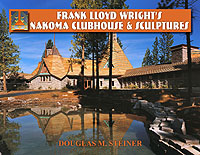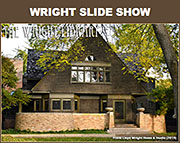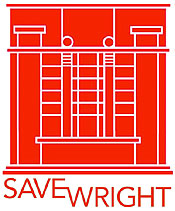|
|
|
|
|
ARIZONA BILTMORE |
1998
 |
Arizona
Biltmore (1927 - S.221) Banquet Plate 1998. 12" Banquet Dinner Plate. Gilt
edge trimmed in the pattern of the concrete blocks used in the construction
of the hotel. In the center is an illustration of the Midway Gardens’
Sprite, and "Arizona Biltmore." In 1987, the Taliesin Associated Architects
donated three reproduction Midway Garden Sprites to the Arizona Biltmore.
The concrete architectural statues were originally designed in 1914 by Frank
Lloyd Wright for the Midway Gardens of Chicago. They are now displayed near
the entrance to the Arizona Biltmore. Printed on the verso: "Eschenbach
Porzellan Germany, (C) 1998, Eschenbach USA 031". To the right is a white
stamp "516". 12" diameter. |
1998.81.0316 |
|
BETH SHOLOM SYNAGOGUE |
1969
 |
Beth
Sholom Synagogue (1954 - S.373), 1969 - Small Wedgewood plate commemorating
the 50th anniversary of the founding of the Beth Sholom Synagogue, Elkins
Park, Pennsylvania. The small plate in blue and white jasperware was
manufactured in Stoke-on-Trent, Barlaston, England in 1969. The appliqué of
the Synagogue was modeled by the Wedgwood artisan Tom Harper after original
design by Frank Lloyd Wright. The oak leaf and acorn border was taken from
the 18th century Wedgwood pattern. The special issue commemorates the 50th
anniversary of the founding of the Synagogue in 1919. It was designed by
Frank Lloyd Wright
in 1954. Gold letters printed on the bottom, "Beth Sholom Synagogue, Elkins
Park, Pennsylvania. 50th Anniversary 1919 - 1969. Architect: Frank Lloyd
Wright." Stamped "Wedgewood, Made in England." Diameter: 4 3/8". |
1803.12.1212 |
|
|
AVERY COONLEY |
1993
 |
Avery
Coonley Teapot & Two Cups, Art Institute of
Chicago |
1993.17.0800 |
|
FLORIDA
SOUTHERN COLLEGE |
1962
 |
Florida
Southern College Danforth and Pfeiffer Chapels Wedgewood 1962 Plate. White
china plate featuring and illustration of Danforth Chapel, with a glimpse of
the Pfeiffer Chapel in the background. Rim is decorated with red flowers.
Verso: "Florida Southern College, Lakeland" seal. "First Issue. Danforth and
Pfeiffer Chapels, Frank Lloyd Wright Architecture, Florida Southern College,
Lakeland, Florida." Marked with the "Wedgwood of Etruria & Barlaston, Made
in England" seal and "Engraved By The Wedgwood Studios" seal. Impressed in
plate "Wedgwood 9 0 62." 10.4" round plate. |
1526.18.1014 |
|
|
|
|
HOTEL GENEVA |
C 1920
 |
Hotel
Geneva Round Ceramic Plate Circa 1920 (1911 - S.171). Text on face: "Hotel
Geneva, Lake Geneva, Wis." Text on verso: "Painted and imported for H.
Rogers & Son. Lake Geneva, Wis." In gold: "Hand Painted, The Jonroth
Studios. Germany."8.2" Round Plate, 1.125" deep. The image is the same as a
postcard published circa 1920 (3581). Building has been painted white. One
flag is visible on the top left corner of the Lobby. Landscaping is
flourishing. "Hotel Geneva" lettered across the front of the Lobby above the
windows. Light poles visible above base. "Hotel Geneva" sign and four globe
street light visible in the foreground on the corner. The plate is bordered
in gold. For additional information see
Hotel Geneva Post Cards. |
0142.12.1014 |
C 1920
 |
Hotel Geneva
Demitasse Ceramic Coffee Cup Circa 1920 (1911 - S.171). Text on face: "Hotel
Geneva, Lake Geneva, Wis." Text on base: "Painted and imported Exclusively
for L. C. Leonard, Lake Geneva, Wis. Hand Painted, The Jonroth Studios.
Germany. 2.75 Round, 3.7" with handle, 2.75 tall. The image is the same as a
postcard published circa 1920 (3581). Building has been painted white. One
flag is visible on the top left corner of the Lobby. Landscaping is
flourishing. "Hotel Geneva" lettered across the front of the Lobby above the
windows. Light poles visible above base. "Hotel Geneva" sign and four globe
street light visible in the foreground on the corner. The cup is bordered in
gold. |
0142.25.0120 |
1920's
 |
Hotel
Geneva Plate. The Jonroth Studio Small hand painted ceramic plate, 5.25
x 5". The back reads: "Hand Painted, The Jonroth Studios. Germany. Designed and Imported Exclusively for L. C. Leonard. Lake Geneva, Ws." For additional information see
Hotel Geneva Post Cards. |
0142.03.0402 |
1920's
 |
Hotel Geneva Ash Tray. The Jonroth Studio Small hand painted octagonal
ash tray, 5.25 x 5.25". The back reads: "Hand Painted, The Jonroth Studios.
Germany. Designed and Imported Exclusively for L. C. Leonard. Lake Geneva,
Ws." For additional information see
Hotel Geneva Post Cards. |
0142.04.0203 |
1920's
 |
Hotel
Geneva Small Square Plate Circa 1920 (1911 - S.171). The Jonroth Studio
small hand painted ceramic plate. Front: "Hotel Geneva, Lake Geneva, Wis."
Hand painted picture of the Hotel Geneva in a 2.8" circle, text in banner
below. Corners of the plate are folded toward the center. Gold designs
printed on all four sides. Back: "Hand Painted, The Jonroth Studios.
Germany. Designed and Imported Exclusively for L. C. Leonard. Lake Geneva,
Ws." 5.1 x 5.1. For additional information see
Hotel Geneva Post Cards. |
0142.10.1213 |
1920's
 |
“Hotel Geneva, Lake Geneva, Wis.” Back: “H. Rogers & Son. Headquarters for
Classy Souvenir. Lake Geneva, Wis. Made in Germany.” 5.25" Round Plate. For additional information see
Hotel Geneva Post Cards. |
0142.05.0207 |
|
|
IMPERIAL HOTEL |
1937
 |
Imperial Hotel Dessert Plate. 1937.
Tokyo, Japan (1915 - S.194) (demolished 1968) Wright designed the china for
the hotel’s main dining room. The porcelain china is rimmed with an elegant
checkerboard pattern of matt and gilt gold. The decorative border mimics the
design of the windows in the Imperial Hotel designed by Wright. The motif
for the windows, had narrow bands of gold-leaf checkerboard alternating with
clear glass. White porcelain with 22 karat gold detail. Produced by
"Noritake, Nippon Toki Kaisha, 1937". 7.6 inches. Three pieces. |
0429.22.0415 0429.23.0615 0429.24.0615 |
1960
 |
Imperial Hotel Small Plate. 1960. Tokyo, Japan (1915 - S.194) (demolished
1968) Wright designed the china for the hotel’s main dining room. The
porcelain china is rimmed with an elegant checkerboard pattern of matt and
gilt gold. The decorative border mimics the design of the windows in the
Imperial Hotel designed by Wright. The motif for the windows, had narrow
bands of gold-leaf checkerboard alternating with clear glass. White
porcelain with 22 karat gold detail. Produced by "Noritake, Nippon Toki
Kaisha, Japan, 1960". 7.6 inches. |
1458.42.0113 |
1961
 |
Imperial
Hotel "Cabaret" China, Salad Plate, 1961. In 1913,
Frank Lloyd Wright designed the Midway Gardens. Two "City by the Sea"
murals, on the
North and South walls
of the tavern were composed of overlapping circles.
Frank Lloyd Wright Graphic
Artist, Fowler, 2002, p.49, 51. The
Imperial Hotel was built between 1915 and 1923. Wright designed two china
place settings. The setting for the main dining room was rimmed with an
elegant checkerboard pattern of matt and gilt gold. This set, designed about
1922 for the Cabaret dining room, utilized the overlapping circular theme
and added a stylized circular "IH" monogram. This china was produced in six
colors: red, yellow, light green, black, gold and beige. Produced for the
Imperial Hotel by "K. Wakabayashico, Yokohama, Tokyo, 1961." Note: Salad
plate had a different design than the Dinner Plate. See
Decorative
Designs Hanks, 1999, Plate 13. Acquired
from the estate of Wright apprentice
Earl Nisbet.
Salad Plate 8". |
1483.29.1216 |
1961
 |
Imperial Hotel “Cabaret” China, Tokyo, Japan, Five Salad Plates, 1961 (1915
- S.194). Five salad plates from the Imperial Hotel’s Cabaret dining
room. In 1913, Frank Lloyd Wright designed the Midway Gardens. Two “City by
the Sea” murals, on the
North and South walls
of the tavern were composed of overlapping circles.
Frank Lloyd Wright Graphic
Artist, Fowler, 2002, p.49, 51. The Imperial Hotel was
built between 1915 and 1923. Wright designed two china place settings. The
setting for the main dining room was rimmed with an elegant checkerboard
pattern of matt and gilt gold. This set, designed about 1922 for the Cabaret
dining room, utilized the overlapping circular theme and added a stylized
circular “IH” monogram. This china was produced in six colors: red, yellow,
light green, black, gold and beige. Produced for the Imperial Hotel by “K.
Wakabayashico, Yokohama, Tokyo, 1961.” Note: Salad plate had a different
design than the Dinner Plate. See
Decorative
Designs, Hanks, 1999, Plate 13. Providence: Imperial Hotel,
Tokyo, Japan. Acquired from the Thomas S. Monaghan, Domino’s private
Collection. Salad Plate 8". |
1483.41.0624
(A-E) |
1961/62
 |
Imperial Hotel "Cabaret" China, Cup and Saucer, 1961/62. In 1913, Frank
Lloyd Wright designed the Midway Gardens. Two "City by the Sea" murals, on
the North and South walls of the
tavern were composed of overlapping circles. "Frank Lloyd Wright Graphic
Artist," Fowler, 2002, pages 49, 51. The Imperial Hotel was built between
1915 and 1923. Wright designed two china place settings. The setting for the
main dining room was rimmed with an elegant checkerboard pattern of matt and
gilt gold. This set, designed about 1922 for the Cabaret dining room,
utilized the overlapping circular theme and added a stylized circular "IH"
monogram. Saucer (5.25"), cup ( 3.4"w x 2.1"h). This china was produced in
six colors: red, yellow, light blue, light green, black and gold (18 karat).
Produced for the Imperial Hotel by "Noritake, Nippon Toki Kaisha, Japan."
Saucer "1961," Cup "1962." |
1483.25.0415 |
1964
 |
Imperial Hotel
"Cabaret" China Saucer, 1964. In 1913,
Frank Lloyd Wright designed the Midway Gardens. Two "City by the Sea"
murals, on the
North and South walls of
the tavern were composed of overlapping circles. "Frank Lloyd Wright Graphic
Artist," Fowler, 2002, pages 49, 51. The Imperial Hotel was built
between 1915 and 1923. Wright designed two china place settings. The setting
for the main dining room was rimmed with an elegant checkerboard pattern of
matt and gilt gold. This set, designed about 1922 for the Cabaret dining
room, utilized the overlapping circular theme and added a stylized circular
"IH" monogram. Saucer (5.25"). This china was produced in six colors: red,
yellow, light blue, light green, black and gold (18 karat). Produced for the
Imperial Hotel by "Noritake, Nippon Toki Kaisha, Japan." Saucer "1964." |
1596.73.0819 |
1984
 |
Imperial Hotel “Cabaret” Dinnerware Set of Seven, 1984
(1915 - S.194). Frank Lloyd Wright designed the Midway Gardens in 1913. Two
"City by the Sea" murals, on the
North and South walls of
the tavern were composed of overlapping circles. "Frank Lloyd Wright Graphic
Artist," Fowler, 2002, pages 49, 51. The Imperial Hotel was built
between 1915 and 1923. Wright designed two china place settings. The setting
for the main dining room was rimmed with an elegant checkerboard pattern of
matt and gilt gold. This dinnerware set, designed about 1922 for the Cabaret
dining room, utilized the overlapping circular theme and added a stylized
circular "IH" monogram. This set was also produced in 1979 with the
“Noritake, N, Japan (Red Square)” identification mark and the text “The Oak
Park Collection, 1979.”
In 1984, Heinz & Co. reproduced this Cabaret Dinnerware pattern. This china
was produced in six colors: red, yellow, light blue, light green, black and
gold (18 karat). The base of each of the seven pieces has the “Noritake, N,
Japan (Red Square)” identification mark and the text “Heinz And Co. 1984.”
The complete Imperial Hotel Dinnerware set of seven pieces includes: A)
Dinner Plate: 10.75" B) Salad Plate: 8.25" C) Bread and Butter
Plate: 6.5" D) Soup Bowl: 7.5...
Continue... |
1984.63.0224 |
1984
 |
Imperial Hotel "Cabaret" China, Bread and Butter Plate, 1984. In 1913, Frank
Lloyd Wright designed the Midway Gardens. Two "City by the Sea" murals, on
the North and South walls of the
tavern were composed of overlapping circles. "Frank Lloyd Wright Graphic
Artist," Fowler, 2002, pages 49, 51. The Imperial Hotel was built between
1915 and 1923. Wright designed two china place settings. The setting for the
main dining room was rimmed with an elegant checkerboard pattern of matt and
gilt gold. This set, designed about 1922 for the Cabaret dining room,
utilized the overlapping circular theme and added a stylized circular "IH"
monogram. The complete 1984 set included a dinner plate (10.75"), salad
plate (8.25"), bread/butter plate (6.5"), soup bowl (7.5"), salad bowl
(5.5"), saucer (6"), cup 3.5"w x 2.25"h). This china was produced in six
colors, red, yellow, light blue, light green, black and gold (18 karat). We
have confirmed that it was also issued in 1954 and 1979 by Noritake, and by
Tiffany and Co. Manufactured by Noritake, Japan for Heinz and Co., 1984.
Bread / butter plate, 6.5". |
1984.44.0914 |
1990
 |
Imperial Hotel Demitasse Tea Service. 1990. "The commission for the Imperial
Hotel, Tokyo, Japan, c. 1912-1923 (demolished 1968) provided Wright with the
opportunity to create a total unified design that included all the
decorative details, from the furnishings and carpets to ceramics and silver.
For the hotel’s main dining room, the porcelain china was rimmed with an
elegant checkerboard pattern of matt and gilt gold. Wright also utilized the
motif for the windows, which had narrow bands of gold-leaf checkerboard
alternating with clear glass. Our china is fine white porcelain with 22
karat gold detail. Made in Japan." (Manufacturer’s Description). Includes
Tea Pot and four Cups and Saucers. Produced by the Frank Lloyd Wright
Foundation. |
1990.81.1010 |
1990
 |
Imperial Hotel Salad Plate 1990. Tokyo, Japan (1915 - S.194) (demolished
1968) Wright designed the china for the hotel’s main dining room. The
porcelain china is rimmed with an elegant checkerboard pattern of matt and
gilt gold. The decorative border mimics the design of the windows in the
Imperial Hotel designed by Wright. The motif for the windows, had narrow
bands of gold-leaf checkerboard alternating with clear glass. White
porcelain with 22 karat gold detail. Produced by "Tiffany & Co., Japan,
1990". Printed on back of plate: "Imperial. A Design by Frank Lloyd Wright.
Certified by the Frank Lloyd Wright Foundation. For Tiffany & Co. © 1990 F.
L. Wright FDN. Japan." 7.5 inches. Original list price $50.00. |
1990.00.1113 |
2000
 |
Imperial Hotel Cup & Saucer, Noritake, Frank Lloyd Wright Collection |
2000.21.1202 |
|
|
LARKIN CO. |
Circa 1910
 |
Larkin
Co. Sugar Bowl with Lid circa 1910 (1903 - S.093). Buffalo Pottery was
formed in 1901, in Buffalo, NY, and started production of semi-vitreous ware
in 1903. Semi-vitreous is a form of porcelain china. This identifying mark
"Semi-vitreous, Buffalo Pottery" with the illustration of the Buffalo is
undated, but we have identified identical marks which are dated 1907 through
1917 to date. According to Jack Quinan,
Frank Lloyd Wright’s
designs for the Larkin Administration building were completed in 1904. The
finished building was ready for occupancy in August 1906 "Myth
and Fact", 1989, p. xiii. The first form of the Larkin "LCO"
monogram that we were able to locate appeared on the July 1905 cover of "The
Larkin Idea". Although it did not appear on the cover of the January
1907 "The Larkin Idea",
it appeared in a slightly different form on pages 26-27, suggesting the use
of the "Larkin monogram" as part of a table centerpiece for the Larkin Club
of Ten. This newer design for the monogram appeared on the cover of the July
1907 issue and the design for the cover stayed consistent through at least
the February 1908 issue. Photographically the first appearance of the
monogram, that we could locate, was published in the March 1908
Architectural Record. Located at the information bureau in the building’s
entrance, the monogram is designed...
Continue... |
0094.39.0214 |
1916

 |
Larkin
Co. Demitasse Cup & Two Saucers (1903 - S.093). Ground was broken in the
Spring of 1902 for the Buffalo Pottery Company, a subsidiary of the Larkin
Company. The plant went into full production in the fall of 1903. Original
intended to provide premiums for the Larkin catalog, it soon became one of
the finest potteries in the country. The name was changed to Buffalo China
Inc., and was purchased by Oneida in 1983. (Larkin
p199) The Larkin Restaurant was located on the top floor of the
Administration Building, designed by
Frank Lloyd Wright.
In 1912, 45,000 visitors of the Larkin Factories enjoyed "wholesome and
dainty refreshments" (Larkin Idea, p5). This saucer was most likely used in
the Larkin Restaurant, not as a give-away premium. There is no evidence that
Wright designed the "LCo" logo, although the other design elements on the
saucer were taken from design elements of the Wright designed Administration
Building. An earlier form of the logo appeared as early as 1905. The logo
that appeared on the cup and saucer appeared on the cover of the July 1907 "Larkin
Idea". The cup measures 2.5 inches across the top and 2.25 inches
high. The saucer measures 5" in diameter. "Buffalo China, 1916." |
0132.14.0712 0132.15.1212 |
1916
 |
Larkin
Co. Salad Plate (1903 - S.093). Ground was broken in the Spring of 1902 for
the Buffalo Pottery Company, a subsidiary of the Larkin Company. The plant
went into full production in the fall of 1903. Original intended to provide
premiums for the Larkin catalog, it soon became one of the finest potteries
in the country. The name was changed to Buffalo China Inc., and was
purchased by Oneida in 1983. (Larkin
p199) The Larkin Restaurant was located on the top floor of the
Administration Building, designed by
Frank Lloyd Wright.
In 1912, 45,000 visitors of the Larkin Factories enjoyed "wholesome and
dainty refreshments" (Larkin Idea, p 5). This plate was most likely used in
the Larkin Restaurant, not as a give-away premium. There is no evidence that
Wright designed the "LCo" logo, although the other design elements on the
saucer were taken from design elements of the Wright designed Administration
Building. An earlier form of the logo appeared as early as 1905. The logo
that appears on the plate appeared on the cover of the July 1907 "Larkin
Idea". The salad plate measures 8.4" in diameter. Imprinted on the
bottom: "Buffalo China, 1916." |
0132.20.0114 |
1916
 |
Larkin Company
Serving Platter 1916. Frank Lloyd Wright began designing the Larking
Administration Building in 1903, and completed the design in 1904. The
finished building was ready for occupancy in August 1906. The Larkin
Restaurant was located on the top floor of the Administration Building. In
1912, 45,000 visitors of the Larkin Factories enjoyed "wholesome and dainty
refreshments" (Larkin Idea, p5). Ground was broken in the Spring of 1902 for
the Buffalo Pottery Company, a subsidiary of the Larkin Company. The plant
went into full production in the fall of 1903. Original intended to provide
premiums for the Larkin catalog, it soon became one of the finest potteries
in the country. The name was changed to Buffalo China Inc., and was
purchased by Oneida in 1983 (Larkin
p199). This serving platter was used in the restaurant and
includes the stylized "LCo" monogram in the design. This example of the
monogram was published in the January 1907
The Larkin Idea.
The other design elements on the platter were taken from design elements of
the Wright designed Administration Building. Imprinted on the bottom:
"Buffalo China, 1916." 11.5" x 8" x 1.1" deep. |
0136.07.0419 |
1928
 |
Larkin
Co. Dessert Plate (1903 - S.093). Rouge and ivory dessert plate with black
line and Larkin logo. Ground was broken in the Spring of 1902 for the
Buffalo Pottery Company, a subsidiary of the Larkin Company. The plant went
into full production in the fall of 1903. Original intended to provide
premiums for the Larkin catalog, it soon became one of the finest potteries
in the country. The name was changed to Buffalo China Inc. By 1928 Buffalo
China developed white plus five solid colors: Ye Old Ivory (ivory); Lune
Ware (medium to light blue); Rouge Ware (pink); Colorido Ware (yellow); and
Cafe-au-Lait (deep tan). Combinations with an ivory center: Colorido Lamelle
(yellow and ivory); Lune Lamelle (medium blue and ivory) and Rouge Lamelle
(pink and ivory). Rouge Ware was the name given by Buffalo Pottery to pink
solid-body vitreous ware. Vitrified China was a strong high-grade ceramic
ware fired at a high temperature to a glasslike finish. It had a low
water-absorption rate. We identified Rouge Ware markings undated, 1928 and
1930. In 1932, Buffalo Pottery was granted US Patent 1849272. The Larkin
Restaurant was located on the top floor of the Administration Building,
designed by
Frank Lloyd Wright.
In 1912, 45,000 visitors of the Larkin Factories enjoyed "wholesome and
dainty refreshments" (Larkin Idea, p5). This plate...
Continue... |
0215.12.0314 |
|
LINCOLN
INCOME LIFE |
C
1970
 |
Lincoln Income Life
Insurance Company, Louisville, Kentucky, (Completed in1966), Large ceramic
Ashtray Circa 1970s. The fifteen story office building was built under the
leadership of Lincoln Income president John T. Acree, Jr. Designed by
William Wesley Peters and the Taliesin Associated Architects. Peters married
Wright's adopted daughter Svetlana in 1935, but lost her and a son eleven
years later in a car crash. He became the head of Wright's architectural
firm Taliesin Associates after Wright's death in 1959. Peters based the
design of the Louisville complex on a unbuilt design Wright created in 1945
for the Sarabhai Calico Mills Store, Ahmadabad, India. In 1986, following
Lincoln Income's acquisition by Conceco Insurance of Indianapolis, Kaden
Companies Partnership acquired the building and changed its name to the
Kaden Tower. Manufactured by Morgan Plastics, Nashville, Tennessee. Morgan
Plastics began in 1946 and later became Morgan Enterprises. Ceramic Ashtray
8.75 round x 1" deep. Illustration in four colors plus gold rim. |
1846.29.1115 |
C
1970
 |
Lincoln Income Life
Insurance Company, Louisville, Kentucky, (Completed in1966), Ceramic Dish
Circa 1970s. The fifteen story office building was built under the
leadership of Lincoln Income president John T. Acree, Jr. Designed by
William Wesley Peters and the Taliesin Associated Architects. Peters married
Wright's adopted daughter Svetlana in 1935, but lost her and a son eleven
years later in a car crash. He became the head of Wright's architectural
firm Taliesin Associates after Wright's death in 1959. Peters based the
design of the Louisville complex on a unbuilt design Wright created in 1945
for the Sarabhai Calico Mills Store, Ahmadabad, India. In 1986, following
Lincoln Income's acquisition by Conceco Insurance of Indianapolis, Kaden
Companies Partnership acquired the building and changed its name to the
Kaden Tower. Manufactured by Morgan Plastics, Nashville, Tennessee. Morgan
Plastics began in 1946 and later became Morgan Enterprises. Ceramic Dish,
6.9" round x 7/8" deep. Illustration in four colors plus gold rim. |
1846.31.1215 |
C
1970
 |
Lincoln Income Life
Insurance Company, (Completed in1966), Round metal dish Circa 1970s. The
fifteen story office building was designed by William Wesley Peters and the
Taliesin Associated Architects. Peters married Wright's adopted daughter
Svetlana in 1935, but lost her and a son eleven years later in a car crash.
He became the head of Wright's architectural firm Taliesin Associates after
Wright's death in 1959. Peters based the design of the Louisville complex on
a unbuilt design Wright created in 1945 for the Sarabhai Calico Mills Store,
Ahmadabad, India. In 1986, following Lincoln Income's acquisition by Conceco
Insurance of Indianapolis, Kaden Companies Partnership acquired the building
and changed its name to the Kaden Tower. Metal dish 4.4 round x .5" deep.
|
1846.30.1115 |
|
MIDWAY GARDENS |
1914
 |
Midway Gardens Large Oval
Platter, Chicago, Illinois, 1914 (1913 - S.180). Original large glazed porcelain oval
platter. Designed for Midway Gardens, Chicago, by Frank Lloyd Wright. Midway
Gardens covered a city block and included the exterior summer garden with
performance stage and an interior Winter Garden for year round
entertainment. Wright designed the complete structure: furnishings,
furniture, sculptures, murals, windows, dinnerware, monogram, a complete
work of art.
The Midway Garden monogram and plate designed by Frank Lloyd Wright. The
platter is bordered with red squares, approximately 0.1875" x 0.1875." On
the inside edge of the squares is a black oval line. The red squares are
approximately .75 inches apart. The monogram is black lettering within a
black rectangle, with a small red triangle. Manufacturer's mark is impressed
in the base: "Bauscher Weiden." Also impressed in the base is “6.” and maybe
“h”. Provenance: Midway Gardens, Chicago / Private Collection, Owner of the
Ward W. Willits House, Highland Park, IL. Acquired from Toomey & Co., 2024.
Large platter. 12.9" Wide by 8" Deep x 1.375" High. |
0124.78.1024 |
1914
 |
Midway Gardens Medium Oval
Platter, Chicago, Illinois, 1914 (1913 - S.180). Original medium glazed porcelain oval
platter. Designed for Midway Gardens, Chicago, by Frank Lloyd Wright. Midway
Gardens covered a city block and included the exterior summer garden with
performance stage and an interior Winter Garden for year round
entertainment. Wright designed the complete structure: furnishings,
furniture, sculptures, murals, windows, dinnerware, monogram, a complete
work of art.
The Midway Garden monogram and plate designed by Frank Lloyd Wright. The
platter is bordered with red squares, approximately 0.1875" x 0.1875." On
the inside edge of the squares is a black oval line. The red squares are
approximately .75 inches apart. The monogram is black lettering within a
black rectangle, with a small red triangle. Stamped manufacturer's mark and
date to underside in red: "New York-Chicago Bauscher Weiden (Germany) 1914".
Provenance: Midway Gardens, Chicago; Private Collection. Toomey & Co.,
Chicago. Acquired from Toomey & Co., 2024. Large platter. 9.75" by 6". |
0124.67.0324 |
1914
 |
Midway Gardens Small Oval
Platter, Chicago, Illinois, 1914 (1913 - S.180). Original small oval platter.
Designed for Midway Gardens, Chicago, by Frank Lloyd Wright. Midway Gardens
covered a city block and included the exterior summer garden with
performance stage and an interior Winter Garden for year round
entertainment. Wright designed the complete structure: furnishings,
furniture, sculptures, murals, windows, dinnerware, monogram, a complete
work of art.
The Midway Garden monogram and the design of the plate is by Frank Lloyd
Wright. The platter is bordered with red squares, approximately 0.1875" x
0.1875." On the inside edge of the squares is a black oval line. The red
squares are approximately .75 inches apart. The monogram is black lettering
within a black rectangle, with a small red triangle. Marked on the bottom in
red: "New York-Chicago Bauscher Weiden (Germany) 1914". Impressed mark in
oval: "Bauscher Weiden." Separate impressions: "00" and “F.” Small platter.
7" by 4.5". |
0124.64.0224 |
1914
 |
Midway Gardens Small
Plate, Chicago, Illinois, 1914 (1913 - S.180). Original small glazed porcelain plate.
Designed for Midway Gardens, Chicago, by Frank Lloyd Wright. Midway Gardens
covered a city block and included the exterior summer garden with
performance stage and an interior Winter Garden for year round
entertainment. Wright designed the complete structure: furnishings,
furniture, sculptures, murals, windows, dinnerware, monogram, a complete
work of art.
The Midway Garden monogram and plate were designed by Frank Lloyd Wright.
The plate is bordered with red squares, approximately 0.1875" x 0.1875." On
the inside edge of the squares is a black circular line. The red squares are
approximately .75 inches apart. The monogram is black lettering within a
black rectangle, with a small red triangle. Stamped manufacturer's mark and
date to underside in red: "New York-Chicago Bauscher Weiden (Germany) 1914".
Impressed in the base is a barely visible “15.” Provenance: Midway Gardens,
Chicago; Private Collection. Small plate, 5.875." |
0124.69.0724 |
|
| |
|
|
|
|













































